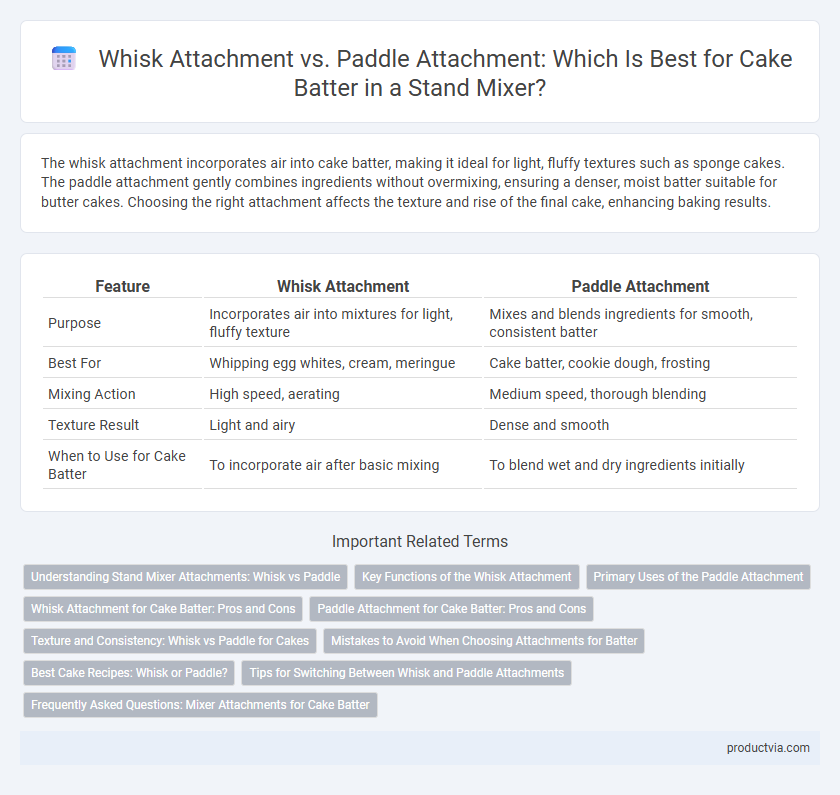The whisk attachment incorporates air into cake batter, making it ideal for light, fluffy textures such as sponge cakes. The paddle attachment gently combines ingredients without overmixing, ensuring a denser, moist batter suitable for butter cakes. Choosing the right attachment affects the texture and rise of the final cake, enhancing baking results.
Table of Comparison
| Feature | Whisk Attachment | Paddle Attachment |
|---|---|---|
| Purpose | Incorporates air into mixtures for light, fluffy texture | Mixes and blends ingredients for smooth, consistent batter |
| Best For | Whipping egg whites, cream, meringue | Cake batter, cookie dough, frosting |
| Mixing Action | High speed, aerating | Medium speed, thorough blending |
| Texture Result | Light and airy | Dense and smooth |
| When to Use for Cake Batter | To incorporate air after basic mixing | To blend wet and dry ingredients initially |
Understanding Stand Mixer Attachments: Whisk vs Paddle
Stand mixer attachments play a crucial role in achieving the perfect cake batter consistency; the whisk attachment aerates ingredients thoroughly, incorporating air for light and fluffy cakes, while the paddle attachment mixes batter more gently, ensuring a smooth texture without over-beating. Using the whisk is ideal for whipping eggs and cream to create volume, whereas the paddle is preferred for combining heavy ingredients like butter and sugar to produce a dense, uniform batter. Choosing between these attachments depends on the desired cake texture, with the whisk promoting lightness and the paddle maintaining structure.
Key Functions of the Whisk Attachment
The whisk attachment is designed to incorporate air into cake batter, creating a light and fluffy texture essential for sponge cakes and angel food cakes. Its key function is rapid whipping, which efficiently aerates egg whites and cream, producing stable peaks and smooth mixtures. Unlike the paddle attachment, the whisk excels in blending liquid and airy ingredients without overmixing or deflating the batter.
Primary Uses of the Paddle Attachment
The paddle attachment is primarily used for mixing cake batter to achieve a smooth, consistent texture without incorporating excessive air. It efficiently combines ingredients like butter, sugar, and flour, ensuring even distribution for a tender crumb. This attachment is ideal for medium to heavy mixtures, providing thorough blending without over-beating.
Whisk Attachment for Cake Batter: Pros and Cons
The whisk attachment aerates cake batter efficiently, creating a lighter texture by incorporating more air compared to the paddle attachment. It excels in whipping egg whites and cream, producing fluffy results, but can overmix denser batters, leading to a tougher cake. For optimal cake texture, the whisk is best used when a light, airy batter is desired, while the paddle attachment suits thicker, heavier mixtures.
Paddle Attachment for Cake Batter: Pros and Cons
The paddle attachment is ideal for cake batter as it thoroughly combines ingredients without overmixing, maintaining a tender crumb and smooth texture. Its flat blade design efficiently incorporates butter, sugar, and eggs, resulting in uniform batter consistency. However, it may struggle with very thick or heavy mixtures, requiring occasional scraping of the bowl to ensure all ingredients are fully blended.
Texture and Consistency: Whisk vs Paddle for Cakes
Whisk attachments aerate cake batter by incorporating air, resulting in a light and fluffy texture ideal for sponge and chiffon cakes. Paddle attachments mix ingredients more gently, providing a denser, more consistent crumb suitable for butter cakes and denser batters. Choosing between whisk and paddle directly impacts the final cake's crumb structure and moisture retention.
Mistakes to Avoid When Choosing Attachments for Batter
Using a whisk attachment for dense cake batter can lead to overbeating, resulting in a tough texture instead of a light crumb. The paddle attachment is ideal for mixing batter evenly without incorporating excess air, preventing common mistakes like uneven mixing or gluten overdevelopment. Avoid confusing these attachments to ensure the perfect consistency and structure in your cake batter.
Best Cake Recipes: Whisk or Paddle?
The whisk attachment aerates cake batter, incorporating air for light and fluffy textures ideal for sponge and chiffon cakes. The paddle attachment mixes ingredients thoroughly without overbeating, preserving structure for denser cakes like pound or butter cakes. Choosing between whisk or paddle depends on the cake recipe's desired crumb and moisture balance.
Tips for Switching Between Whisk and Paddle Attachments
When switching between whisk and paddle attachments for cake batter, ensure the whisk is used for incorporating air into egg whites or light mixtures, while the paddle is ideal for creaming butter and sugar or mixing dense ingredients. Always scrape down the sides of the bowl when changing attachments to maintain even consistency and avoid overmixing. Start mixing at a low speed after switching to prevent splattering and gradually increase to the recommended speed for the attachment type.
Frequently Asked Questions: Mixer Attachments for Cake Batter
The whisk attachment incorporates more air into cake batter, making it ideal for light, fluffy textures like sponge cakes and meringues. The paddle attachment, also known as the flat beater, is better suited for denser batters such as butter cakes and cookie dough, offering thorough yet gentle mixing without over-aerating. Choosing the right mixer attachment affects texture and consistency, so understanding the differences ensures optimal cake results.
Whisk attachment vs Paddle attachment for cake batter Infographic

 productvia.com
productvia.com